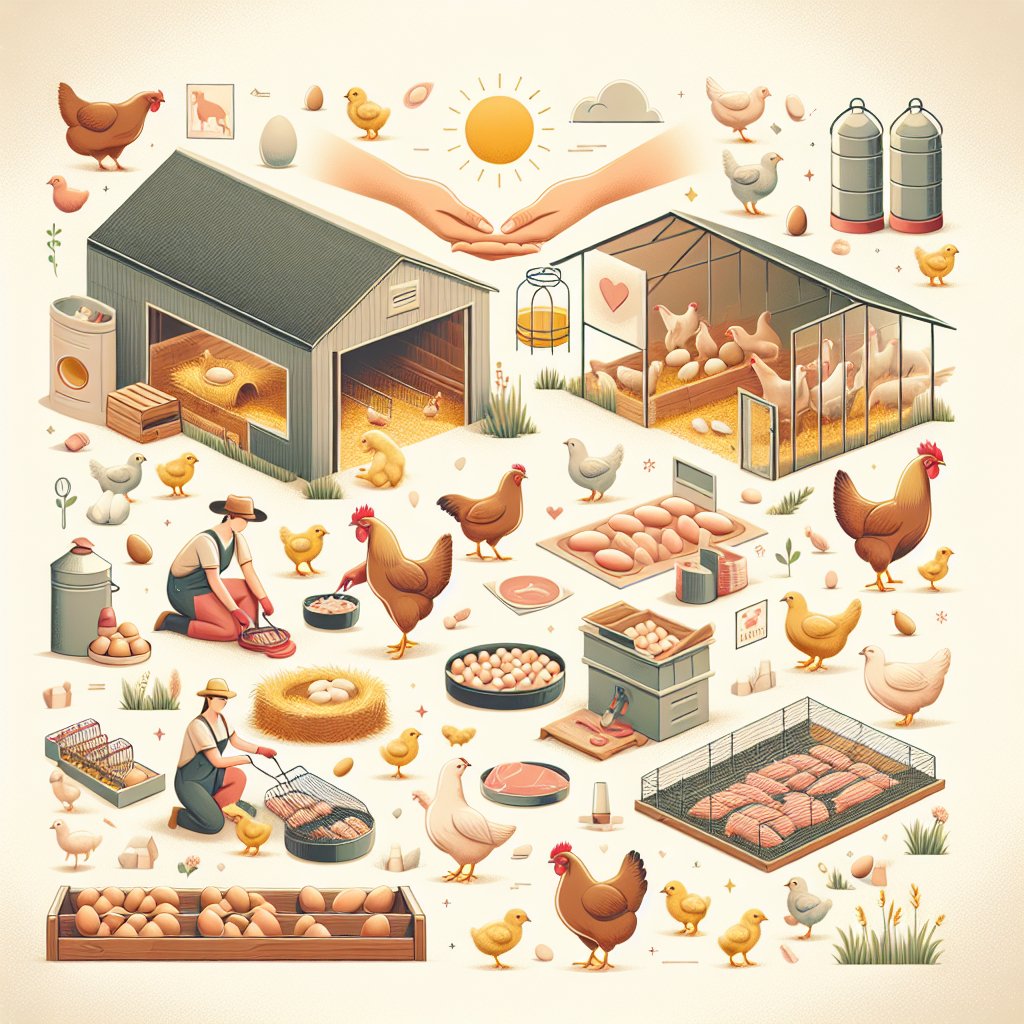Raising chickens for eggs and meat is a rewarding endeavor that combines sustainable living with the joy of animal husbandry. Whether you are a seasoned farmer or a beginner looking to start a small backyard flock, understanding the essentials of chicken care is crucial for success. This article will guide you through the process of raising chickens, from selecting the right breeds to ensuring their health and productivity.
Choosing the Right Breeds
One of the first steps in raising chickens is selecting the appropriate breeds for your needs. Chickens are generally categorized into three types: egg layers, meat producers, and dual-purpose breeds. Each type has its own set of characteristics that make them suitable for specific purposes.
Egg-Laying Breeds
For those primarily interested in egg production, choosing breeds known for their high egg yield is essential. Breeds such as the Leghorn, Rhode Island Red, and Sussex are renowned for their prolific egg-laying capabilities. These chickens are typically smaller in size and have a high feed-to-egg conversion ratio, making them efficient producers.
- Leghorn: Known for their white eggs and high production rate, Leghorns are a popular choice for commercial egg production.
- Rhode Island Red: These chickens are hardy and adaptable, producing brown eggs and thriving in various climates.
- Sussex: A dual-purpose breed that is also an excellent egg layer, producing light brown eggs.
Meat-Producing Breeds
If your goal is to raise chickens for meat, selecting breeds that grow quickly and have a good feed-to-meat conversion ratio is important. Broiler chickens, such as the Cornish Cross, are specifically bred for meat production and are ready for processing in a relatively short time.
- Cornish Cross: The most common breed for meat production, known for its rapid growth and large breast size.
- Jersey Giant: A slower-growing breed that produces a larger carcass, ideal for those who prefer a more traditional chicken flavor.
Dual-Purpose Breeds
For those who want the best of both worlds, dual-purpose breeds offer a balance between egg production and meat yield. Breeds like the Plymouth Rock and Orpington are excellent choices for small farms and homesteads.
- Plymouth Rock: Known for their friendly nature and good egg production, they also provide a decent amount of meat.
- Orpington: A versatile breed that is both a good layer and a substantial meat producer.
Setting Up the Chicken Coop
Once you have selected your breeds, the next step is to set up a suitable living environment for your chickens. A well-designed chicken coop is essential for the health and productivity of your flock. It should provide protection from predators, shelter from the elements, and enough space for the chickens to move around comfortably.
Coop Design and Construction
The design of your chicken coop will depend on the number of chickens you plan to keep and the space available. A basic coop should include nesting boxes, roosting bars, and a secure run area. Ensure that the coop is well-ventilated to prevent respiratory issues and that it is easy to clean to maintain hygiene.
- Nesting Boxes: Provide one nesting box for every 3-4 hens to ensure they have a comfortable place to lay eggs.
- Roosting Bars: Chickens prefer to sleep off the ground, so provide roosting bars at varying heights.
- Run Area: A secure outdoor space where chickens can forage and exercise is crucial for their well-being.
Feeding and Nutrition
Proper nutrition is vital for the health and productivity of your chickens. A balanced diet will ensure that they lay eggs consistently and grow at a healthy rate. Commercial chicken feed is formulated to meet the nutritional needs of different types of chickens, but you can also supplement their diet with kitchen scraps and garden waste.
- Layer Feed: High in calcium and protein, this feed is designed for egg-laying hens.
- Broiler Feed: Rich in protein to support rapid growth in meat-producing chickens.
- Grit and Oyster Shells: Provide grit to aid digestion and oyster shells for additional calcium.
Maintaining Chicken Health
Keeping your chickens healthy is essential for a productive flock. Regular health checks, vaccinations, and parasite control are important aspects of chicken care. Observing your chickens daily will help you spot any signs of illness early and take appropriate action.
Common Health Issues
Chickens are susceptible to various health issues, including respiratory infections, parasites, and nutritional deficiencies. Being aware of common symptoms and having a basic understanding of treatment options can help you manage these problems effectively.
- Respiratory Infections: Symptoms include coughing, sneezing, and nasal discharge. Ensure good ventilation and seek veterinary advice if needed.
- Parasites: Regularly check for lice and mites, and use appropriate treatments to keep them at bay.
- Nutritional Deficiencies: Ensure a balanced diet to prevent issues such as weak eggshells and poor growth.
Biosecurity Measures
Implementing biosecurity measures is crucial to prevent the spread of diseases within your flock. Limit access to your chickens, regularly clean and disinfect the coop, and quarantine new birds before introducing them to the flock.
- Limit Visitors: Restrict access to your chicken area to reduce the risk of disease transmission.
- Quarantine New Birds: Isolate new chickens for at least two weeks to monitor for any signs of illness.
- Regular Cleaning: Clean the coop and replace bedding regularly to maintain a healthy environment.
Conclusion
Raising chickens for eggs and meat can be a fulfilling and sustainable practice, providing fresh produce and a deeper connection to the food you consume. By choosing the right breeds, setting up a suitable living environment, and maintaining their health, you can ensure a productive and happy flock. Whether you are raising chickens for personal use or as part of a larger farming operation, the principles outlined in this article will help you achieve success in your poultry endeavors.



